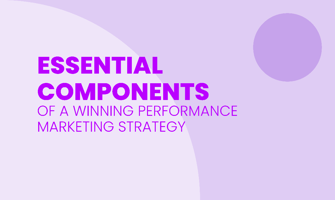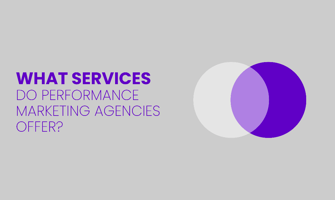Performance marketing is a results-driven approach to online marketing where businesses only pay...
How to Design Effective Performance Marketing Campaigns
Businesses must have a clear plan to create a successful performance marketing campaign. This plan should focus on measurable results and clear goals.
First, identify the target audience, set specific key performance indicators (KPIs), and select appropriate marketing channels. To enhance conversions and improve all campaign aspects, including messaging and targeting, regular testing and analysis enable data-driven adjustments, ensuring continuous improvement.
A strong performance marketing campaign increases ROI and provides valuable insights for future efforts. This article will explain performance marketing campaigns, which are created to reach specific goals.
Discover the basics of Performance Marketing in our article, "What is Performance Marketing? A Starter Guide."
What are Performance Marketing Campaigns?
Performance marketing campaigns are advertising efforts where businesses pay only when a specific action is completed, such as a click, lead, or sale. Instead of paying upfront for ad placements, companies focus on measurable results.
These campaigns typically run on digital platforms like search engines, social media, or affiliate networks.
The main goal is to track performance and optimize ads based on real-time data to improve outcomes. This approach helps businesses control costs while maximizing their return on investment (ROI).
![]()
Steps to Design Effective Performance Marketing Campaigns
1. Define Clear Objectives
Defining clear objectives means setting specific goals for your marketing campaign, such as increasing website traffic, generating leads, or boosting sales. These goals help guide your strategy and measure success.
180ops helps businesses align their revenue goals with actionable insights, ensuring that data-driven decisions consistently support clear objectives.
Importance
Provides direction and focus for the campaign.
It helps in selecting the right strategies and channels to achieve goals.
Makes it easier to track progress and measure success.
Implementation Techniques
Identify objectives: Begin by clarifying your campaign’s core purpose, whether it's to boost sales or raise brand awareness. Clear objectives provide direction and purpose for the entire marketing effort.
Set SMART goals: Ensure that your goals are Specific, Measurable, Achievable, Relevant, and Time-bound. This structured approach guarantees that your objectives are realistic and trackable for campaign success.
Break down objectives: Split your main goals into smaller, actionable steps for each campaign phase. This helps manage the campaign efficiently and ensures smoother progression.
Use goals to guide decisions: Let these smaller goals inform decisions about your audience targeting, messaging, and budget. They ensure that every choice aligns with your main campaign objectives.
2. Understand Your Audience
Understanding your audience means knowing who your customers are, what they want, and how they behave. This helps create marketing messages that connect with them effectively.
Importance
Helps create ads that speak directly to the needs and interests of your target customers.
Allows you to focus on the right platforms and channels where your audience spends time.
Increases the chances of conversions by targeting the right people with the right message.
Implementation Techniques
Research your audience: Analyze audience demographics, preferences, and behaviors to understand who your campaign will target. This insight will help you create more effective and relevant marketing strategies.
Use data collection tools: Leverage tools like surveys, social media insights, and website analytics to collect detailed information. These tools provide real-time, actionable data that improves audience understanding.
Segment your audience: Based on the data, divide your audience into distinct groups. Segmentation allows you to tailor content to specific needs, maximizing engagement.
Create personalized ads: Develop customized ads that address each segment's unique preferences and challenges. Personalization increases relevance, fostering stronger connections with each group.
3. Choose the Right Channels
Choosing the right channels means selecting the platforms where your target audience is most active, ensuring your marketing efforts reach the right people effectively.
Importance
It ensures your ads are shown to the audience most likely to engage or convert.
Helps in optimizing your marketing budget by focusing on high-performing platforms.
Improves campaign efficiency by targeting the right audience through the best mediums.
Implementation Techniques
Research target audience's online behavior: Find out where your audience spends most of their time online, like social media, search engines, or specific websites. This helps you know where to focus.
Analyze past campaign performance: Look at the results of your past campaigns to see which channels worked best. This helps improve future efforts.
Allocate budget strategically: Spend more money on the channels that perform well and help reach your goals faster.
Monitor performance: Keep checking results regularly and make changes to improve your campaign when needed.
4. Create Compelling Content
Creating compelling content means crafting messages, images, or videos that capture attention, engage your audience, and motivate them to take action. It’s about making content that resonates with people and encourages interaction.
Importance
Attracts the right audience by delivering relevant and engaging information.
Increases the chances of conversions by building interest and trust.
Supports campaign goals by encouraging users to click, sign up, or make a purchase.
Implementation Techniques
Understand audience needs: Researching your audience helps you learn about their preferences, interests, and pain points. This knowledge allows you to tailor your campaign to address what they care about most, making it more relevant and effective.
Develop clear messages: Create simple, engaging messages that speak directly to your audience’s problems or goals. The clearer the message, the more likely it is to resonate and encourage action.
Incorporate attention-grabbing elements: Use compelling visuals, strong headlines, and clear call-to-actions to immediately capture your audience’s attention and guide them toward taking the next step.
Test different content formats: Experiment with various content formats like videos, infographics, and blogs to see which performs best with your target audience. This testing allows you to optimize your campaigns for better results.
5. Implement Tracking and Analytic
Implementing tracking and analytics means setting up tools to monitor the performance of your marketing efforts. This helps you see what works and where improvements are needed by collecting real-time data on clicks, conversions, and user behavior.
Importance
Helps track the success of your campaign by measuring key performance indicators (KPIs).
Provides insights into audience behavior, allowing you to optimize campaigns based on real data.
Ensures you can adjust your strategy in real time for better results and higher ROI.
Implementation Techniques
Set up tracking codes/pixels: Install tracking codes or pixels on your website and ads to collect data on user interactions. This will help you track important actions like clicks, purchases, or sign-ups, giving you insights into your campaign’s performance.
Use analytics tools: Tools like Google Analytics help you monitor user behavior, showing what actions they take after interacting with your ads. These tools allow you to measure success and make informed decisions.
Review data regularly: Regularly analyze the collected data to identify which parts of your campaign are performing well and which need improvement. This helps in optimizing the campaign over time.
Adjust targeting and messaging: Use data insights to refine your targeting strategy and messaging. By focusing on what resonates best with your audience, you can improve the effectiveness of your campaign and achieve better results.
6. Test and Optimize
Test and optimize means trying different versions of your ads or strategies to see which one works best, then improving them based on the results to get better outcomes.
Importance
It helps identify what messaging, targeting, or visuals lead to higher conversions.
Allows for continuous improvement based on real data, ensuring better performance over time.
Reduces wasted spend by focusing on the most effective strategies.
Implementation Techniques
Create multiple ad versions: Develop various versions of your ad by tweaking elements like wording, images, or targeting. This allows you to see which combination is more appealing to different audience segments.
Run and track performance: Use tracking tools to monitor how each version performs in real-time. This helps you understand which ads are driving more clicks, conversions, or engagements.
Identify the best-performing version: Analyze the performance data to find out which version yields the best results, allowing you to focus on what works.
Focus on successful strategies – Once the best-performing version is identified, prioritize it for future campaigns while continuing to test new ideas. This ensures that you constantly improve and evolve your marketing strategies.
7. Budget Allocation
Budget allocation is the process of deciding how much money to spend on different areas of a marketing campaign. It ensures that resources are used efficiently to achieve the best results.
Importance
Helps prioritize spending on the most effective marketing channels.
Ensures proper resource distribution to maximize return on investment (ROI).
Prevents overspending by setting clear financial limits for each campaign.
Implementation Techniques
Analyze past campaign performance: Review past campaigns to identify which marketing channels have delivered the best results. This helps in understanding where to focus future efforts for maximum impact.
Allocate budget strategically: Based on your analysis, allocate the budget across channels in a way that aligns with the campaign goals and the potential of each channel to deliver results.
Track expenses continuously: Monitor spending during the campaign to ensure that your budget is being used efficiently and in line with performance goals.
Adjust budget as needed: If certain channels are performing better than others, shift more of the budget towards them to maximize the campaign's overall effectiveness.
Conclusion
Creating a successful performance marketing campaign isn’t just a one-and-done task; it requires thoughtful planning and a willingness to adapt along the way.
By establishing clear goals and selecting the right channels to reach your audience, you can set yourself up for success. Keeping an eye on how your campaign is performing allows you to make adjustments and improvements as needed.
Regularly testing your strategies based on real data can lead to better results over time. With the right strategies in place, you can boost your conversions, increase your return on investment, and ultimately help your business thrive.
FAQ
1. What are the key steps in designing a performance marketing campaign?
The key steps include defining clear objectives, understanding your audience, choosing the right marketing channels, creating compelling content, implementing tracking tools, and continuously testing and optimizing strategies.
2. Why is it important to define clear objectives?
Clear objectives help set the direction of your campaign, making it easier to track progress and measure success based on specific goals like sales, clicks, or leads.
3. How can understanding your audience improve campaign performance?
By understanding your audience’s preferences and behaviors, you can create more targeted campaigns, leading to higher engagement and conversion rates.
4. How do agencies choose the right marketing channels?
Agencies select channels based on audience behavior, past performance data, and the business’s goals to ensure maximum ROI.
5. What role does compelling content play in performance marketing?
Compelling content attracts and engages the audience, encouraging them to take specific actions, like signing up for a service or making a purchase.




